
Edmund Beaman Gilchrist (March 13, 1885 - December 18, 1953) was an American architect, best remembered for his English-Cotswold and French-Norman suburban houses.

Edmund Beaman Gilchrist (March 13, 1885 - December 18, 1953) was an American architect, best remembered for his English-Cotswold and French-Norman suburban houses.
Born in Philadelphia, Pennsylvania, he attended Germantown Friends School, Drexel University for a year, and graduated from the University of Pennsylvania in 1906. He apprenticed in the offices of architects Horace Trumbauer and Wilson Eyre, and launched his own firm in 1911.
In the 1880s and 1890s, architects G. W. & W. D. Hewitt designed more than 100 houses in the Chestnut Hill section of Philadelphia for developer Henry H. Houston. A generation later, Dr. George Woodward, Houston's son-in-law, hired Gilchrist, H. Louis Duhring Jr., and Robert Rodes McGoodwin to expand the planned community, building dozens of freestanding houses and attached houses grouped to look like manor houses. The Woodward houses were rental properties and, a century later, most remain so.
In addition to suburban houses, Gilchrist designed summer houses (especially in Maine), churches, a Moderne-style public library, a Federal-style city hall, and alterations to numerous residences. He designed a 33-story Art Deco skyscraper in Philadelphia, and an Art Deco retail store for the candy manufacturer Whitman & Sons.
He was considered an expert on group housing. Working as an architect for the U.S. Navy during World War I, he designed housing at what is now North Island Naval Air Force Base in San Diego, California. During the Depression, he served on President Herbert Hoover's Conference on Home Building and Home Ownership (1932), and on the national AIA's Special Committee on the Economics of Site Planning and Housing (1934–35). [1] He also designed public housing under the WPA and was one of the Philadelphia Housing Authority architects of the Hill Creek Housing Project (1937).
"Linden Court" (1914–15) was a six-house Georgian Revival development built in Chestnut Hill for Woodward and the Houston Estate. Gilchrist grouped brick double-houses around three sides of a quadrangle, solved the problem of a gently sloping site with terraces, and the problem of back-yard access with covered alleyways. His innovative plan, acute sensitivity to public-versus-private space, and exquisite detailing was recognized as something extraordinary, and received national attention. The development was prominently featured in The Architectural Record (January 1916). The Architectural Forum (July 1917) accompanied a 4-page article with eight pages of photographs. Even the National Housing Association's trade journal, Housing Betterment (February 1918), sang its praises:
Illustrative of the charm of grouped dwellings as one means of retaining uniformity without danger of monotony where a measure of standardization is necessary is a recent residential development known as Linden Court at St. Martin's near Philadelphia. In this the architect, Edmund B. Gilchrist, has achieved several interesting results. By advantageous groupings he was able to put six houses on a piece of land, which treated conventionally would have accommodated but four, or at most five, and he has done this without sacrificing privacy or desirable open space.
The houses, which are of sand-faced brick with slate roofs, are grouped about three sides of a quadrangle 225 feet long by 125 feet deep. They have been pushed back far enough to leave ample space for an individual garden and common grass plot in the quadrangle, but not so far as to eliminate kitchen yards. These yards have been surrounded by a brick wall high enough to secure privacy without cutting off light and air. The houses have six rooms each, the arrangement of which has been sufficiently varied as to give individuality to each home.
While the cost of development and the rents derived from it lifts it out of the class of the "average man's home"—the houses rent for about $50—many of the principles of planning and design which it illustrates are adaptable to lower-cost developments. On the other hand, it touches and solves in a most satisfactory manner the housing problem of the "average man" which, in many communities, is quite as pressing as the industrial housing problem and, as an architectural publication pointed out in describing Linden Court, it is "veritably an exemplification of the truth that beauty pays and that there is no legitimate reason for the desolation of the usual speculative building." [2]
Gilchrist and his wife Anita were among the original residents of Linden Court, moving into the unit at 111 West Willow Grove Avenue in 1915. They raised three sons, and lived there until his death in 1953.

Germantown is an area in Northwest Philadelphia, Pennsylvania. Founded by Palatine, Quaker, and Mennonite families in 1683 as an independent borough, it was absorbed into Philadelphia in 1854. The area, which is about six miles northwest from the city center, now consists of two neighborhoods: 'Germantown' and 'East Germantown'.

Chestnut Hill is a neighborhood in the Northwest Philadelphia section of Philadelphia, Pennsylvania, United States. It is known for the high incomes of its residents and high real estate values, as well as its private schools.

Frank Heyling Furness was an American architect of the Victorian era. He designed more than 600 buildings, most in the Philadelphia area, and is remembered for his diverse, muscular, often inordinately scaled buildings, and for his influence on the Chicago-based architect Louis Sullivan. Furness also received a Medal of Honor for bravery during the Civil War.

Wayne Junction station is a SEPTA Regional Rail junction station located at 4481 Wayne Avenue, extending along Windrim Avenue to Germantown Avenue. The station is located in the Nicetown neighborhood of Philadelphia. Wayne Junction serves as a multi-modal transfer point between six of SEPTA's regional rail lines as well as three major transit routes – the Route 75 Trackless Trolley and the Route 23 and 53 bus lines. The station served more than 321,000 riders annually in 2018.

Tulpehocken station is a SEPTA Regional Rail station in Philadelphia, Pennsylvania. Located at 333 West Tulpehocken Street in the Germantown neighborhood, it serves the Chestnut Hill West Line. The Pennsylvania Railroad built the station in 1878. The station is in zone 2 on the Chestnut Hill West Line, and is 8.5 track miles from Suburban Station. In 2004, this station saw 176 boardings on an average weekday.

Samuel Sloan was a Philadelphia-based architect and best-selling author of architecture books in the mid-19th century. He specialized in Italianate villas and country houses, churches, and institutional buildings. His most famous building—the octagonal mansion "Longwood" in Natchez, Mississippi—is unfinished; construction was abandoned during the American Civil War.

G. W. & W. D. Hewitt was a prominent architectural firm in the eastern United States at the turn of the twentieth century. It was founded in Philadelphia in 1878, by brothers George Wattson Hewitt (1841–1916) and William Dempster Hewitt (1847–1924), both members of the American Institute of Architects. The firm specialized in churches, hotels and palatial residences, especially crenelated mansions, such as Maybrook (1881), Druim Moir (1885–86) and Boldt Castle (1900–04).

Wilson Eyre Jr. was an American architect, teacher and writer who practiced in the Philadelphia area. He is known for his deliberately informal and welcoming country houses, and for being an innovator in the Shingle Style.

George Howe (1886–1955) was an American architect and educator, and an early convert to the International style. His personal residence, High Hollow (1914-1917), established the standard for house design in the Philadelphia region through the early 20th century. His partnership with William Lescaze yielded the design of Philadelphia's PSFS Building (1930–32), considered the first International style skyscraper built in the United States.

The Anglecot, also known as the Potter Residence, is an historic residence in the Chestnut Hill neighborhood of Philadelphia, Pennsylvania, United States.
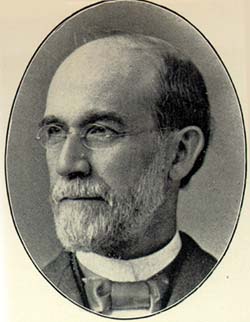
Addison Hutton (1834–1916) was a Philadelphia architect who designed prominent residences in Philadelphia and its suburbs, plus courthouses, hospitals, and libraries, including the Ridgway Library, now Philadelphia High School for the Creative and Performing Arts, and the Historical Society of Pennsylvania. He made major additions to the campuses of Westtown School, George School, Swarthmore College, Bryn Mawr College, Haverford College, and Lehigh University.
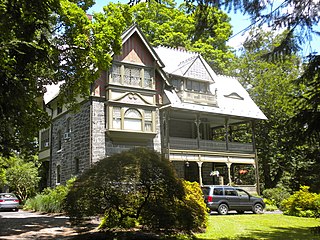
The Chestnut Hill Historic District is a historic area covering all the Chestnut Hill section of Philadelphia, Pennsylvania.
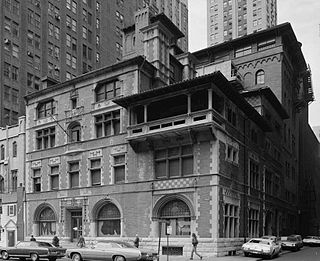
Frank Miles Day was a Philadelphia-based architect who specialized in residences and academic buildings.

Herman Louis Duhring Jr. was an American architect from Philadelphia, Pennsylvania. He designed several buildings that are listed on the U.S. National Register of Historic Places.

The Tulpehocken Station Historic District is a historic area in the Germantown neighborhood of Philadelphia, Pennsylvania. Large suburban houses were built in the area from about 1850 to 1900 in a variety of styles including Carpenter Gothic, Italianate, and Bracketed as part of the Picturesque Movement of architecture. In the 1870s styles moved toward High Victorian and Second Empire. The district was added to the National Register of Historic Places in 1985, and it covers about six square blocks, bounded by McCallum Street on the north, the Pennsylvania Railroad tracks on the south, Tulpehocken Street on the west, and Walnut Lane on the east. Thirty-seven buildings in the district are considered to be significant and 118 are considered to be contributing, with only 13 considered to be intrusions.

Autun, also known as Meadowcourt, is a historic home located in West Whiteland Township, Pennsylvania, United States. Designed by the architect Edmund Beaman Gilchrist in 1928 and completed in 1929, it is a 1+1⁄2-story, French style, L-shaped country house.
Cedar Crest – originally known as "Dolobran II", and recently as "Linden Hill" – is a French-Norman-style mansion and estate at 1543 Monk Road in Gladwyne, Pennsylvania. Located on a hill overlooking the Schuylkill River, it was designed by architect Edmund B. Gilchrist, 1928–31. Best known as the former residence of Campbell's Soup-heir John T. Dorrance, Jr., it is a contributing property in the Mill Creek Historic District.
Robert Rhodes McGoodwin was an American architect and educator, best known for his suburban houses in the Chestnut Hill and Mount Airy sections of Philadelphia, Pennsylvania. He taught at University of Pennsylvania from 1910 to 1924, and served as a trustee of its School of Fine Arts from 1925 to 1959. McGoodwin was active in the Philadelphia Chapter of the American Institute of Architects, serving as its president in 1943.
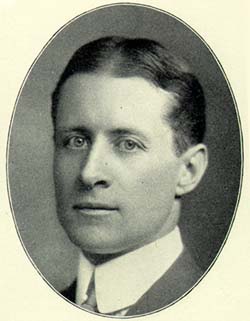
Edgar Viguers Seeler (1867–1929) was an American architect.
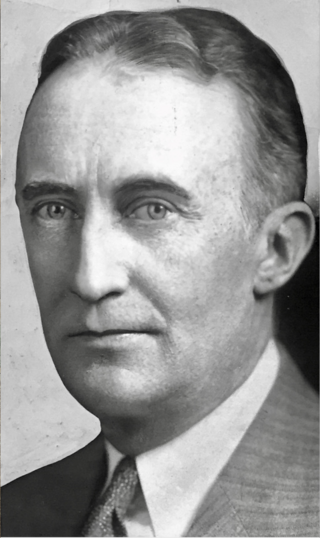
Walter Horstmann Thomas (1876–1948) was an American architect from Philadelphia whose career spanned 44 years. He is best known for approximately eighty church designs.